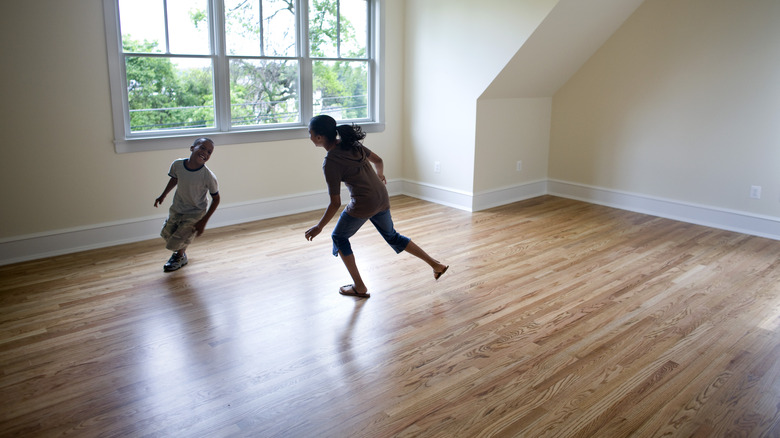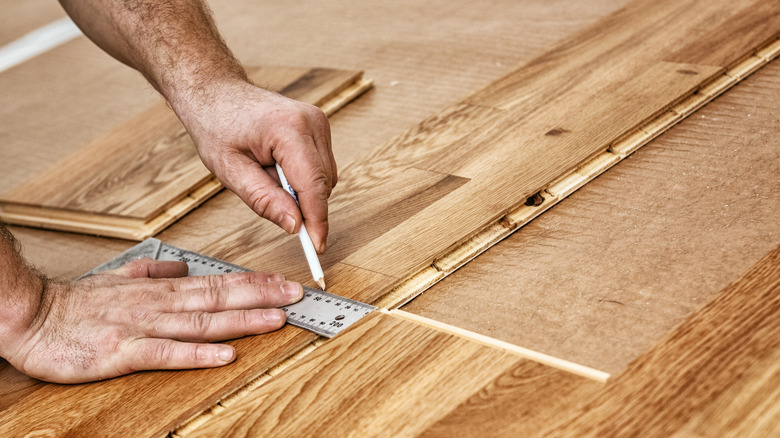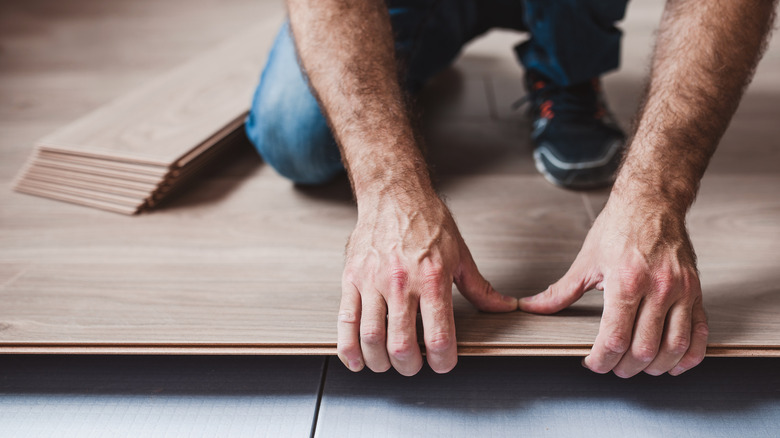The Major Benefit Of Engineered Hardwood Floors, According To Pinterest
Picking out the perfect flooring for your home isn't always easy, but engineered hardwood floors have been getting a lot of love recently, especially on Pinterest. Indeed, they're pretty cool stuff since they're made with a real hardwood top layer that gives you that authentic wood floor look. Below that, a base of plywood or high-density fiberboard gives the whole thing a lot of stability and a bit of flex. This means you get the beauty of hardwood with some extra perks.
Now, here's where it gets interesting. You've got options on how to install engineered hardwood. Whether you're thinking about gluing it down, floating it (no glue needed), nailing, or stapling, it's all doable. It plays nice with different types of subfloors, too, like wood, concrete, or tile. Recently, they've started making engineered hardwood that clicks together — the planks just snap into place, no mess, no fuss. It's a dream come true for DIYers and pros who want to get the job done quickly and without complications. All in all, engineered hardwood offers that classic look and durability to stand up to everyday life. Whatever your home's situation, there's a way to make engineered hardwood work for you. And because it's built tough, it's also more forgiving in places where moisture might be an issue, unlike traditional hardwood.
Glued vs. nailed engineered hardwood
When it comes to installing engineered hardwood, glued-down and nailed methods are like the dynamic duo of durability and stability. Each has its superpowers tailored to different needs and spaces. Gluing down engineered wood floors involves spreading a special adhesive on the subfloor before laying down the planks one by one. What makes the glued-down approach a winner, especially in bustling areas of the house, is how it locks everything in place. There's no shifting or squeaking — just steady, reliable flooring underfoot. This means high heels and pet claws are less of a worry. As for the nailed method, it's all about precision and strength and requires use of a nail gun to fasten each plank to a wooden subfloor — think of it as giving your floors a permanent embrace. It's perfect for spaces that see a lot of action — nailing down ensures your floors are going nowhere by providing a secure fit that can handle a lot of hustle and bustle. Plus, with this method, you're less likely to deal with shifting or creaking boards over time.
In short, if you're after a flooring solution that's going to stick with you through thick and thin, going the glued-down route with engineered wood is a solid choice that requires less equipment, making it a go-to for residential projects. On the flip side, nailed installations bring industrial-grade durability suited for business and commercial settings.
Floating floor installations for engineered hardwood
Floating wood floors have transformed how we think about laying down engineered hardwood. In short, they are the DIY dream. Imagine each plank of your floor fitting together seamlessly, like pieces of a giant jigsaw puzzle. This is the essence of a floating floor: It rests on top of the subfloor, anchored by its own weight and the genius of its design, rather than being fixed directly to the subfloor beneath it. Forget about nails and glue; this method is all about simplicity and savvy. You can lay them over pretty much any existing floor material — think concrete, plywood, or even old vinyl tiles. There's no need to rip up what's already there, which can be a huge time and budget saver. Plus, the lack of nails and glue means you're not committing to a flooring layout for life. If you love changing up your space, this is as flexible as it gets. The speed and simplicity of installing a floating floor are unmatched.
But here's the catch: It's all in the preparation. To avoid that hollow sound when you walk, it's crucial to start with a level subfloor and consider adding a quality underlayment. This extra layer not only helps with soundproofing but also adds a bit of cushioning, making your walk more comfortable. In a nutshell, if you're looking for a floor that combines ease of installation with a chic, modern look, a floating engineered hardwood floor makes a straightforward, flexible solution that fits perfectly into busy lives.


